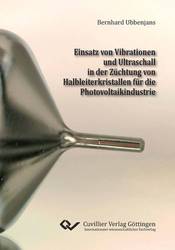| Departments | |
|---|---|
| Book Series (96) |
1378
|
| Nachhaltigkeit |
3
|
| Gesundheitswesen |
1
|
| Humanities |
2364
|
| Natural Sciences |
5406
|
| Mathematics | 229 |
| Informatics | 319 |
| Physics | 980 |
| Chemistry | 1363 |
| Geosciences | 131 |
| Human medicine | 243 |
| Stomatology | 10 |
| Veterinary medicine | 108 |
| Pharmacy | 147 |
| Biology | 835 |
| Biochemistry, molecular biology, gene technology | 121 |
| Biophysics | 25 |
| Domestic and nutritional science | 45 |
| Agricultural science | 1004 |
| Forest science | 201 |
| Horticultural science | 20 |
| Environmental research, ecology and landscape conservation | 148 |
| Engineering |
1793
|
| Common |
98
|
|
Leitlinien Unfallchirurgie
5. Auflage bestellen |
|
Advanced Search
Einsatz von Vibrationen und Ultraschall in der Züchtung von Halbleiterkristallen für die Photovoltaikindustrie (English shop)
Bernhard Ubbenjans (Author)Preview
Extract, PDF (580 KB)
Table of Contents, PDF (44 KB)
Kurzbeschreibung
Die vorliegende Arbeit beschäftigt sich mit dem Einsatz von Ultraschall und niederfrequenten Vibrationen in der Kristallzüchtung. Das Ziel ist die optimierte Herstellung von Halbleitermaterial für die Photovoltaikindustrie. Der zukünftige Bedarf an industriell gefertigten Kristallen ist fokussiert auf die Steigerung des Ertrages bei einer gleichzeitigen Erhöhung der Kristallqualität. Dies erfordert die Kontrolle des Stofftransports innerhalb des Schmelzvolumens, welche durch den Einsatz von externen Kraftfeldern erreicht werden kann. Die verfügbare Bandbreite reicht dabei von Magnetfeldern über elektrische Felder bis hin zu mechanischen Kraftfeldern, zu denen auch der Einsatz von Ultraschall und Vibrationen gehört. Die Aufgabe dieser beiden Kraftfelder ist neben der Dämpfung von negativen Strömungsschwankungen insbesondere auch die Reduzierung der Dicke der schädlichen Diffusionsgrenzschicht, die zu morphologischen Instabilitäten führt. Resultierend kann die Wachstumsgeschwindigkeit des Kristalls erhöht werden und es wird die Gefahr des Einbaus von Fremdatomen reduziert.
In dieser Arbeit wurde die Wirkungsweise des Ultraschalls auf die Züchtung von Germanium im VGF-Verfahren analysiert. Dazu wurden sowohl numerische Simulationen als auch praktische Experimente durchgeführt. Mit den Softwareprogrammen ANSYS und FLUENT konnte die Schmelzenströmung simuliert werden. Hierbei wurde insbesondere auf die einsetzende Schlichtingströmung eingegangen, die an der Kristallisationsfront wirkt. Dabei wurde der Einfluss der beiden Parameter, Ultraschallfrequenz und Schallleitergeometrie, untersucht. Des Weiteren wurde auch die Überlagerung eines Ultraschallfeldes mit einemWandermagnetfeld analysiert. Es konnte gezeigt werden, dass der Einsatz von Ultraschall ein wirkungsvolles Mittel zur Reduzierung der Diffusionsgrenzschichtdicke ist. Der Einsatz von niederfrequenten Vibrationen wurde mit dem Program FLUENT numerisch simuliert. Untersucht wurde die Wirkungsweise auf die globale Strömung von Galliumarsenid im VGF-Verfahren. Es zeigte sich, dass die Konvektion im Bereich zwischen Vibratorstempel und Phasengrenze stark erhöht werden kann. Der Einsatz von Vibrationen ist somit ebenfalls als Instrument zur Reduzierung der Dicke der Diffusionsgrenzschicht geeignet.
Description
The subject of the present work is the application of ultrasound and low-frequency vibrations in crystal growth. The goal of these investigations is to optimize the production of semiconductor materials for the photovoltaic industry. The future demands of industrial bulk crystal growth from melt are concentrated on improved crystal quality and increased yield. In order to realize this, a proper control of mass transfer within the fluid phase is required. This can be achieved by applying external forces such as non-steady magnetic fields, electric current, mechanical or ultrasonic vibrations. Besides the damping of violent convective fluctuations, the diffusion boundary layer, causing morphological instability, has to be decreased. As a result the growth velocity can be enhanced, in the same sense as the risc of foreign particle incorporation is minimized.
This study analyzes the effect of ultrasound on the growth of germanium in the VGFprozess. This analysis includes numerical simulations which were carried out as well as practical experiments. With the help of the software programs, ANSYS and FLUENT, the melt flow could be simulated. The main focus was on the analysis of Schlichting streaming that occur at the crystallization front and affect the diffusion boundary layer. The influence of the two parameters, ultrasonic frequency and geometry of the waveguide, have been examined. Furthermore, the superposition of an ultrasonic field with a traveling magnetic field was investigated. The result was that ultrasonic treatment can help to remove the harmful diffusion boundary layer very effectively. The use of low-frequency vibrations was simulated numerically by using the FLUENT software. The influence of vibrations on the global flow of gallium arsenide in the VGF-process was investigated. The simulations showed that the velocity of the convection in the area between the vibrator and the phase boundary can be increased. Therefore vibrations can be considered also as a suitable tool to reduce the diffusion boundary layer.
| ISBN-13 (Hard Copy) | 9783954042982 |
| ISBN-13 (eBook) | 9783736942981 |
| Final Book Format | A5 |
| Language | German |
| Page Number | 136 |
| Lamination of Cover | matt |
| Edition | 1. Aufl. |
| Publication Place | Göttingen |
| Place of Dissertation | Hannover |
| Publication Date | 2012-11-30 |
| General Categorization | Dissertation |
| Departments |
Geosciences
Engineering |
| Keywords | Kristallographie, Technische Mechanik, Strömungsmechanik, Thermomechanik, Kristallzüchtung, VGF-Verfahren, Ultraschall, Vibrationen, numerische Simulation, crystal growth, VGF-process, ultrasound, vibrations, numerical simulations |








